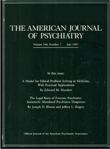TO THE EDITOR: We commend Donald W. Black, M.D., and colleagues (
1) for their publication of empirical data that describe the phenomenology and axis I and II comorbidity associated with “compulsive sexual behavior.” The authors overlooked, however, our prior report that described DSM-III-R axis I comorbidity in 60 male subjects with paraphilias (N=34) and paraphilia-related disorders (N=26) who were seeking psychiatric treatment (
2). Our study both complements and contrasts with the Black et al. findings.
As Black et al. noted, nonparaphilic sexual impulsivity disorders are understudied, and uniform operational criteria to characterize them are lacking. Their study used Coleman's compulsive sexual behaviors typology (
3), which includes some behaviors that are not clearly genital or sexual but are more relational and romantic (e.g., compulsive fixation or erotomania, multiple love relationships). We propose that the term “paraphilia-related disorders” be used to describe nonparaphilic sexual disorders, since this term does not implicitly characterize the form of these disorders (e.g., as impulsive, compulsive, or addictive). Paraphilia-related disorders are sexual disorders that, like paraphilias, are repetitive, intrusive, persist at least 6 months, and are accompanied by psychosocial distress and impairment, but the specific behaviors are not currently considered as socially anomalous or deviant. In our research, the predominant paraphilia-related disorders are ego-dystonic compulsive masturbation, protracted promiscuity, and dependence on pornography. Less prevalent forms include phone sex dependence, severe sexual desire incompatibility, and dependence on sexual accessories such as objects (e.g., dildos) or drugs (e.g., amyl nitrate, cocaine) (
2,
4). Although it is not clearly noted in Black et al.'s report, our studies have consistently found that male subjects with paraphilias, including sex offenders, commonly have paraphilia-related disorders as well.
In our comorbidity study, 28% of male subjects with paraphilias and paraphilia-related disorders described a history of physical or sexual abuse, and the lifetime prevalence of mood disorders (76.7%) (especially early-onset dysthymic disorder [53.3%]), psychoactive substance abuse (46.7%) (especially alcohol abuse [40%]), and anxiety disorders (46.7%) (especially social phobia [31.6%]) did not readily distinguish the paraphilic from the nonparaphilic group. The different prevalence rates of specific axis I disorders in our report, in contrast with Black et. al., could be related to differing methodologies used to establish axis I diagnoses and differing methods of subject ascertainment.

